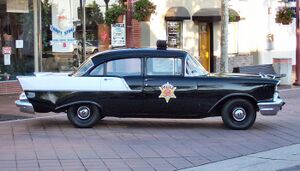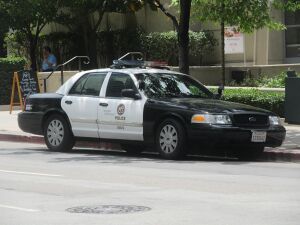Black and white (police vehicle)
Topic: Engineering
 From HandWiki - Reading time: 6 min
From HandWiki - Reading time: 6 min
This article uses relative time references. The year a police service began using the colour scheme should be specified, and the year they stopped using it. If the latter does not (yet) apply, the article should state "as of 2024" (or if currently unknown, "as of <insert last year they were known to be using the colour scheme>"), to avoid confusion and potentially dated statements. (October 2021) |
Black and white is an American slang term for a police car that is painted in large panels of black and white, or generally any "marked" police car. Historically, this scheme is much favoured by North American police forces because it allows the unambiguous recognition of patrol units from a significant distance. However, as the colour scheme is not standardised, each police agency in Canada, Mexico, and the U.S. can choose their own colour scheme.
The most common variant of the black and white colour scheme is a white roof and four white doors; the second most common is the two front doors and roof painted white.
In Finland and Sweden, the black-and-white police cars had black roofs to make them visible in high snow. In European police forces, a colour scheme with blue and white is very common. In Spain , green and white is used by the Civil Guard, and in Germany , green and white was standard, mainly in the past.
Argentina
The Federal Police of Argentina use a colour scheme with dark blue, white and blue. Template:Packed gallery border
Armenia
Yerevan Municipal Police use a black and white colour scheme. Template:Packed gallery border
Brazil
The Civil Police of Rio de Janeiro State use a black and white livery. The top half of the car is white and the bottom half black, with the black sloping downwards as it nears the front of the car. Civil Police of São Paulo State vehicles have a white upper half and a black lower half. Template:Packed gallery border
Canada
Alberta
Calgary Police Service has been replacing its blue-and-white Ford Crown Victoria cars with black-and-white Ford Police Interceptor Sedans since as early as September 2013.[1]
Edmonton Police Service returned to the black and white colour scheme for newly acquired vehicles starting in 2011; existing vehicles retain their white colour scheme.
British Columbia
Abbotsford Police Department of Abbotsford, British Columbia, now[when?] has a black and white scheme for their vehicles.
Saanich Police have chosen a blue-and-white version for their cars.[when?]
South Coast British Columbia Transportation Authority Police Service in British Columbia also uses a black and white scheme.
Vancouver, Victoria, Port Moody, New Westminster, and Central Saanich are all using black and white police cars.
West Vancouver Police Department in British Columbia also has started to use the black and white livery.[when?] Template:Packed gallery border
Ontario
In 2007, Ontario Provincial Police reverted to a black and white scheme for their fleet. The force used this scheme on their police cars from 1941 to 1989, earning them the nickname "Holsteins" during that period, especially in the 1950s. Template:Packed gallery border
Chile
Until 1998, all Carabineros de Chile vehicles were painted with the same pattern that the LAPD uses; the vehicles are now painted with a pattern that includes green and white. Police uniforms in Chile are all green; the green paint on police vehicles complements the uniforms.[citation needed] Template:Packed gallery border
Finland
Finnish police vans are colloquially known as the "Musta Maija" ("Black Maria" or "Black Mary"). Since Finland is a bilingual country, police patrol vehicles feature the text "Police" in both Finnish ("Poliisi", on the vehicle's right side) and Swedish ("Polis", on the driver's side). The old vehicles were black and white like Sweden and Norway 's; the current[when?] ones are white with two dark blue stripes. in 2016, a revision to the livery added reflective markings to the sides of police vehicles. Template:Packed gallery border
France
French police vehicles were[when?] painted like Swedish ones before changing to all white with red/white/blue[clarification needed] striping. In 2018, Paris Police decided to lease 16 eGolfs, painted in a black and white retro style. They were referred to as "pie", French for magpie.
Template:Packed gallery border
Germany
In the past,[when?] German police cars were painted green; this was later changed to green and white, and blue and white. Now,[when?] the standard colour scheme used is silver and blue. Template:Packed gallery border
Georgia
The new[when?] Georgian police vehicles livery are mainly silver and white. Template:Packed gallery border
Iran
During the 20th century, the Iranian police used black and white cars. They now[when?] use green or blue and white. Template:Packed gallery border
Iraq
The Iraqi Kurdistan police use a black and white livery. Template:Packed gallery border
Israel
The Mishteret Yisrael use a new[when?] white and dark blue livery on their cars. The old[when?] one was white and blue. Template:Packed gallery border
Japan
All Japanese police force vehicles are painted and marked in the same ways. Japanese police vehicles are painted black and white with the upper parts of the vehicle painted white. However, motorcycles are usually all white and riot control and rescue vehicles are painted a steel blue. Template:Packed gallery border
Moldova
Moldova police uses both blue and white, and black and white vehicles. Template:Packed gallery border
Mexico
Mexican Federal Police vehicles use a dark blue and white livery. Template:Packed gallery border
New Zealand
All Traffic Police cars of the Ministry of Transport throughout the 1970s and 1980s were black with a white roof and white doors. This distinguished them from the all-white cars of the New Zealand Police. Additionally, MOT patrol cars used red roof lights, while police cars used all-blue roof lights. The traffic enforcement functions of the MOT were merged into the New Zealand Police in 1992 and the black and white colour scheme stopped being used entirely in favour of the single-colour vehicles of the police. Police vehicles continue to be single-colour, usually white, often with Battenberg markings; lightbars are red and blue. Template:Packed gallery border
Norway
Norwegian Police Service vehicles were previously[when?] painted mostly black, with white around the wheels. Template:Packed gallery border
Pakistan
Pakistan National Highways & Motorway Police patrol vehicles are painted in a white and dark blue livery. Template:Packed gallery border
Portugal
Until the mid-1990s, the vehicles of the Lisbon Municipal Police were painted with the same pattern as the Los Angeles Police Department. The black and white livery of the vehicles reflected the colours of the Flag of the City of Lisbon. Since then, vehicles of this police force are painted entirely white, with a stripe along the sides chequered with the black and white gyronny field of the Flag of Lisbon. The old[when?] vehicles of Polícia de Segurança Pública (PSP, Public Security Police), are painted with a blue and white colour scheme. Template:Packed gallery border
Spain
Police in Madrid used black and white livery on their cars until 2016. The Civil Guard used[when?] a green and white livery. Template:Packed gallery border
Sweden
Swedish police vehicles were originally painted black and white in the reverse of the Californian-style pattern. Swedish police vehicles had black roofs, doors, trunk and bonnet or black roofs, bonnet and boot. This came out of necessity, due to the heavy snowfall in Sweden as with high snow obscuring everything but the roof, a white roof would be hard to see. Colloquially they were called black-and-white people-catchers, after a grouping of species of birds referred to as Western Palearctic black-and-white flycatchers.[citation needed] Template:Packed gallery border
Taiwan
The Taiwanese police use black and white cars. Template:Packed gallery border
Turkey
Until 1994, Turkish police used black and white livery on their cars.
United Kingdom
A colour scheme used in the 1960/70s by United Kingdom police forces prompted the colloquial term of "panda car", or just "panda", to refer a small or medium-sized marked British police car.
The term "panda car" was first used to refer to black police cars with panels that had been painted white to increase their visibility. It was later applied to blue and white police cars.
There is a record of Salford City Police using black and white Hillman Minxs in 1960.
The chief constable of the Lancashire Constabulary referred to the use of blue and white Ford Anglia panda cars in Kirkby in an article in The Times on 26 January 1966. Template:Packed gallery border
United States
Los Angeles Police Department
Like most police agencies throughout southern California , Los Angeles Police Department vehicles are ordered painted in black clearcoat with the roof, doors, and pillars painted white from the factory.
Template:Packed gallery border
See also
- Battenburg markings
- Jam sandwich (slang)
- Livery
- Panda car
- SWAT vehicle
- Sillitoe tartan
- Aerial roof markings
- Blues and twos
References
External links
 KSF
KSF

